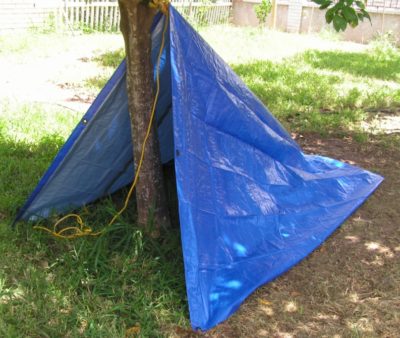Every prepper (and even some who aren’t) eventually creates a bug-out bag, sometimes known as a 72 hour bag. In the event that they need to abandon their home, that bag has the bare necessities to keep them alive and going for the first three days. Actually, the equipment will keep them going longer than that, but the food in the bag is only enough for three days.
Bugging out usually means going into the wilderness, where you can get away from other people. The risk of being around others is often too great to allow. Those other people probably aren’t prepared, so being with them might tempt them to try and hit you over the head and steal your equipment.
For most people, their bug-out bag doesn’t include a tent, due to the weight and bulk of carrying a tent along with them. Even so, shelter is an important part of survival, especially in inclement weather. So, while carrying a tent along may not be practical for everyone, carrying a few basic supplies will make it possible to build yourself a shelter in the wild. These basic supplies are:
- A tarp
- Parachute cord
- A wire saw or wire chainsaw
- Tent stakes (you can get by without these, making them from sticks)
As you will see in a moment, you can construct a shelter, even if you don’t have these ingredients. However, if you have them, you can construct a shelter much quicker and easier.
The major purpose of any shelter is protecting your from the elements. That means that it needs to provide protection from the rain, protection from ground water, protection from wind, protection from the sun, and protection from the cold. These five elements of protection come from selecting the right location and building your shelter in the right way, using the materials that nature provides.
The pack for anybody who wants to be fully prepared for an unexpected emergency
Pick Your Location
The first step in building a shelter is to find a good location. There are several factors in selecting a good location, but the most important one is using the terrain and foliage to your advantage. Foliage and large rocks are excellent protection from wind and can even help keep rain off of your shelter.
Putting your shelter in the lee of a windbreak can go a long way towards protecting you from the cold. Windbreaks can be many things, such the root mass of an uprooted tree, a mound of large rocks, a thicket of evergreen trees, or simply a fold in the earth. Ideally, you want a location that provides protection from the wind in all directions so that your fire is protected as well, although the most important part is to have a windbreak in the direction that the wind is coming from.
Your fire should be located in front of the entrance to your shelter. Having some sort of reflector behind it will help reflect the heat from the fire into your shelter. The best reflector is a large rock, although a large log will work as well.
Overhanging tree branches are another thing to look for. No tent or homemade shelter is ever as waterproof as you would like. Putting your shelter under a large tree can help, as the branches and leaves of the tree will block and divert some of the water. In an emergency, a large pine tree provides excellent shelter. Merely crawl into the natural space that exists under the lower layer of branches. The tree itself will provide a windscreen and watershed for rain, and the needles on the ground under the tree will make a comfortable bed.
The other thing you want is someplace that will shed water well. Most people look for a flat place to pitch their tent, but that just means that if it rains, the water will end up in your shelter. If you can find a place that has a slight slope to it, you can dig a trench uphill of your shelter, which will make the water run around your shelter rather than into it.
Building a Tarp Tent
The easiest form of shelter to build is a tarp tent. This is much like what you did as a kid, making a tent out of a blanket. Use the paracord to tie the tarp in such a way as to make a ridge for the tent. The grommets in the tarp provide you with a way of tying off the tent, as well as anchoring the corners to the ground. Although the door end of the tent needs to be open, the other end shouldn’t be. By folding the tarp, you can use a flap at the end to close it off.
While you can build a tarp tent with just a tarp and a rope, cutting a long, thin branch or sapling with your wire saw provides you with a ridge pole. That will help keep the top of the tent from sagging. A tent pole or tree (like I used in the picture) at the opening of the tent can help as well, although it isn’t necessary.
Spread the tarp over the ridge pole, tying it to it at both ends. Then, peg the tarp to the ground with tent stakes. If you don’t have tent stakes, weighting it down with rocks will work just as well. Another way you can do it is to cut small branches to make a tent stake. Any “Y” in the branch can act as the head of the tent stake, catching against the grommet. Always place your tarp tent in a way that the wind hits the side of it and not the open end. If the wind hits the end, it will drive out all the heat from your shelter, as well as driving rain into it.

This tarp tent was made form an 8’ x 10’ tarp and a pole for the ridge pole. The ridge pole was attached to the tree and then the tarp to the ridge pole. The tarp was spread out and staked at the back and front corners. Total build time was 10 minutes.
Seal out the elements entirely or use like a traditional sleeping bag
For added insulation, layer tree branches and leaves over the tarp. This should always be done from the bottom up, so that water landing on the branches will flow from leaf to leaf or from branch to branch, always staying away from your shelter.
Building a Debris Hut
The forest floor provides ample material for making what is known as a debris shelter. This is a shelter with a similar shape to the tarp tent, but not as high. It provides excellent insulation, as well as descent watershed.
The hard part of building a debris hut is building the framework. This is best made out of thin branches. Start with a ridge pole, much like that of the tarp tent. Attach one end of the ridge pole to a tree or make an a-frame for it, so that it is about two feet off the ground and allow the other end to sit on the ground. Tie small branches to it all down its length, forming an a-frame structure.
Cut small branches with leaves on them and place them over your structure. These are necessary to keep the debris from entering into your shelter. Collect leaves from the forest floor and pile them on your shelter, making it look like a huge leaf pile; the more leaves the better. The leaves provide insulation, fairly good watershed, and camouflage.
A debris hut is not spacious, but you don’t want it to be. Extra space is just air that you have to heat with your body heat. By having it small, so that the walls and roof are close to your body, it provides better insulation for you, without having to add any additional heat.
 Off The Grid News Better Ideas For Off The Grid Living
Off The Grid News Better Ideas For Off The Grid Living




